Artificial Sweetener Market Size
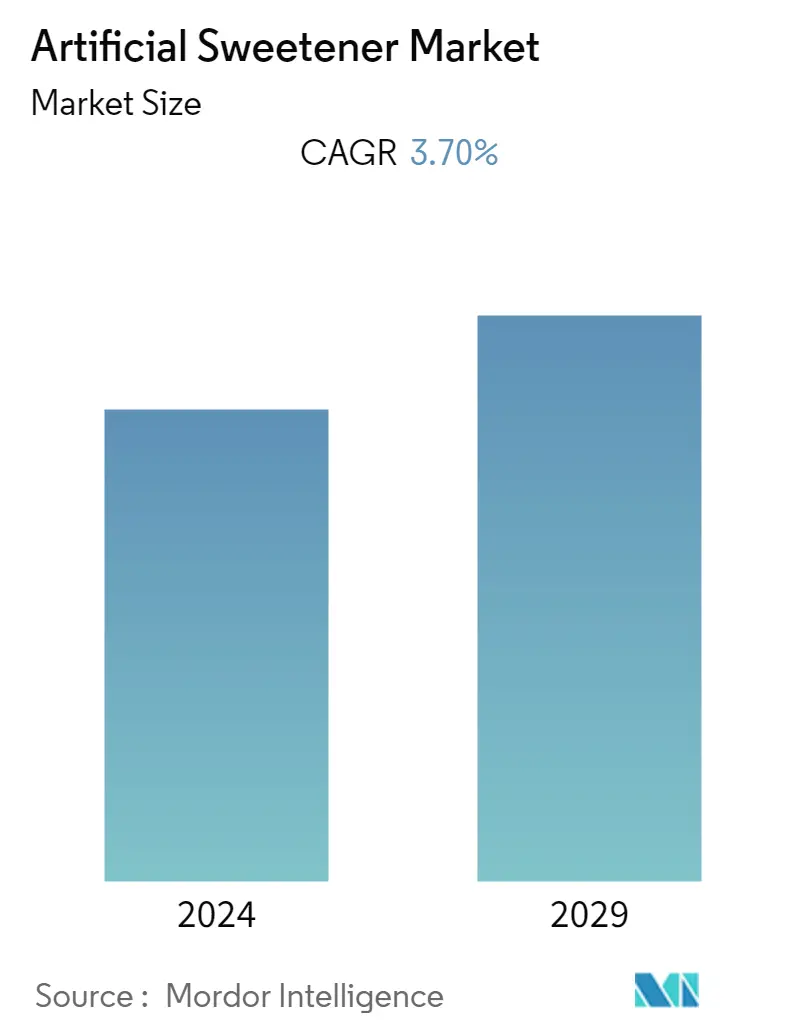
| Study Period | 2019 - 2029 |
| Base Year For Estimation | 2023 |
| CAGR | 3.70 % |
| Fastest Growing Market | Middle East and Africa |
| Largest Market | Asia Pacific |
| Market Concentration | Low |
Major Players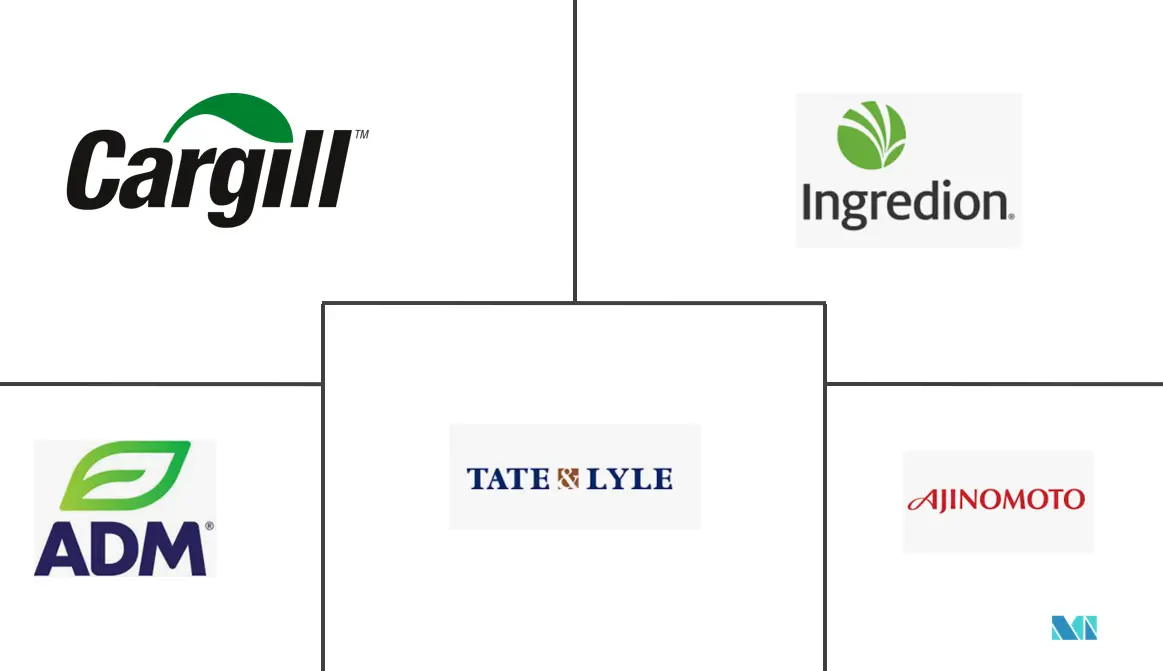
*Disclaimer: Major Players sorted in no particular order |
Artificial Sweetener Market Analysis
The artificial sweetener market is projected to register a CAGR of 3.7% during the upcoming five years.
- Artificial sweeteners are commonly used as a substitute for sugar to maintain blood sugar levels, and they are commonly found in processed foods and beverages such as candies, jams, and baked goods. Aspartame, sodium benzoate, and saccharin are among the most popular artificial sweeteners available in the market, with aspartame being commonly used as a tabletop sweetener that is approximately 200 times sweeter than regular sugar. It is used in low-calorie desserts, sugar-free chewing gum, cereal, and coffee.
- The demand for no-calorie or low-calorie versions of food and beverages has been increasing at a rapid pace in recent years due to the rise in health-conscious consumers across the globe. Artificial sweeteners, which are sweeter than table sugar but have a lower energy density, have been widely used in the food and beverage industry in products such as soft drinks, sauces, chewing gum, jellies, dressings, baked goods, candy, fruit juice, ice cream, and more. The soft drink industry, in particular, has seen a significant increase in the consumption of artificial sweeteners due to the growing demand for low-sugar and diet beverages.
- While concerns about clean-label solutions and complex regulatory structures in Europe and the United States may limit market growth, product innovation and increasing demand for artificial sweeteners may help drive further growth in the market during the forecast period.
Artificial Sweetener Market Trends
Rising Propensity for Low or No-calorie Versions of Foods and Beverages
- The trend of health consciousness among consumers is increasing, with many paying close attention to the sugar and calorie content of their favorite foods. For these individuals, low-calorie claims are crucial when purchasing food or beverages. As a result, artificial sweetener consumption is on the rise, and food manufacturers are using high-intensity artificial sweeteners to create low-calorie products with enticing flavor profiles.
- Artificial sweeteners have virtually no calories when compared to regular sugar, making them a suitable option for overweight or obese individuals, as well as those who are trying to lose weight. These sweeteners are also beneficial for diabetic patients since they do not raise blood glucose levels. Thus, the growing population of individuals with obesity and diabetes is expected to drive the growth of the artificial sweeteners market.
- Sugar-free gums, diet beverages, tabletop sweeteners, yogurt, and frozen dairy products are some of the products that use artificial sweeteners as a key component. Urban residents often find it challenging to maintain a healthy lifestyle due to their busy and sedentary lifestyles, leading to unhealthy habits such as irregular eating and consuming sugary drinks at inappropriate times. As the world's population becomes more sedentary and unhealthy, low-calorie, ready-to-drink (RTD) beverages are expected to become more popular.
- In response to the health-conscious trend, PepsiCo announced in July 2021 its plans to reduce sugar content by 25% in sodas and iced tea beverages across the European Union by 2025. By introducing products with lower sugar content, the company aims to attract health-conscious consumers in the region. The sales of sugar-free gums, for example, have shown significant growth compared to regular gums.
- Overall, the increasing demand for low-calorie and sugar-free products, coupled with the rising prevalence of obesity and diabetes, is expected to drive the growth of the artificial sweeteners market.
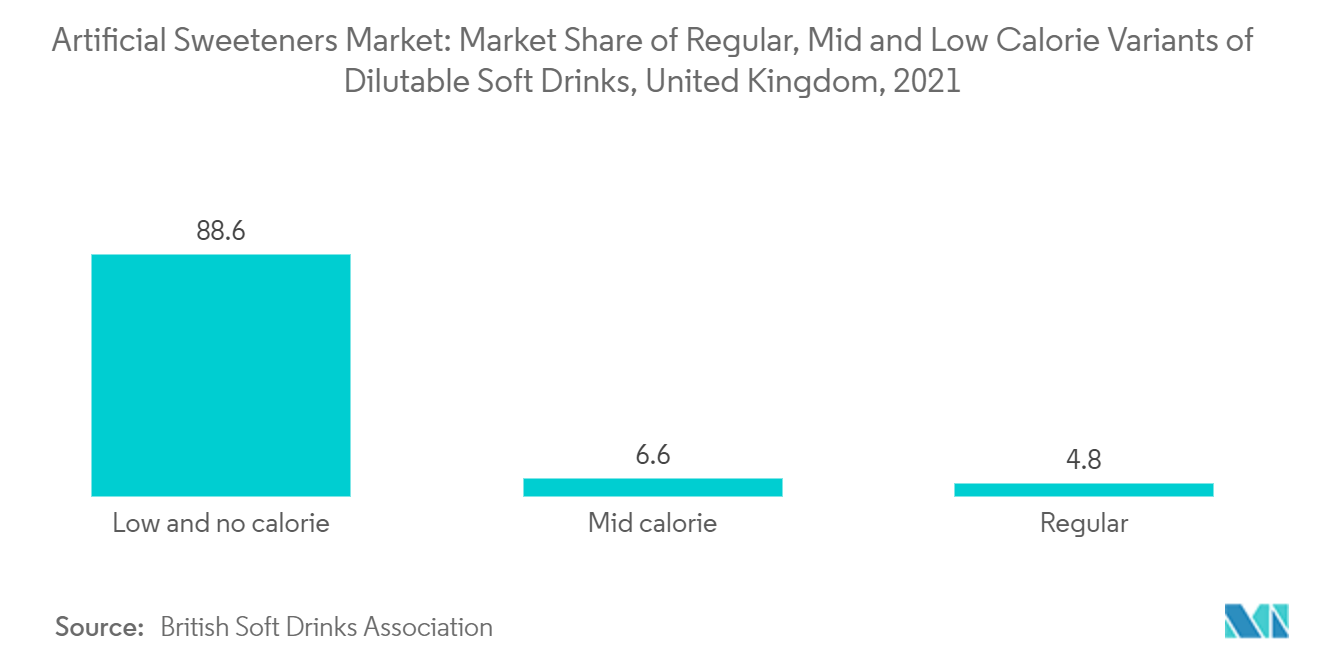
Asia-Pacific is One of the Largest Markets for Artificial Sweeteners
- The artificial sweetener market in the region is being driven by various factors, including the rise in health awareness among consumers and concerns about obesity and diabetes. Consumers are becoming more conscious of the amount of calorie intake and are seeking sugar alternatives to reduce their sugar consumption. This trend of losing weight is also contributing to the growth of the artificial sweetener market.
- The improving economic conditions and changing lifestyles have resulted in an increased demand for convenience foods. As a result, the processed and packed food segment is seeing an increase in demand for low-calorie and zero-calorie foods, which is driving the demand for artificial sweeteners.
- The adoption of sugar alternatives, both natural and artificial, has increased, particularly among obesity and diabetes patients. These conditions are linked to lifestyle diseases such as heart disease, hypertension, stroke, and others. According to a survey conducted in India, the prevalence of overweight or obese women increased from 20.6 percent in 2016 to 24 percent in 2021, while the prevalence among men increased to about 22.9 percent in 2021.
- With rising health consciousness among people, the demand for low-calorie sugar alternatives and sugar-free products is increasing, which is boosting market growth. As a result, food processing companies are producing low-calorie and sugar-free alternatives as their major products, which is helping to stimulate market growth.
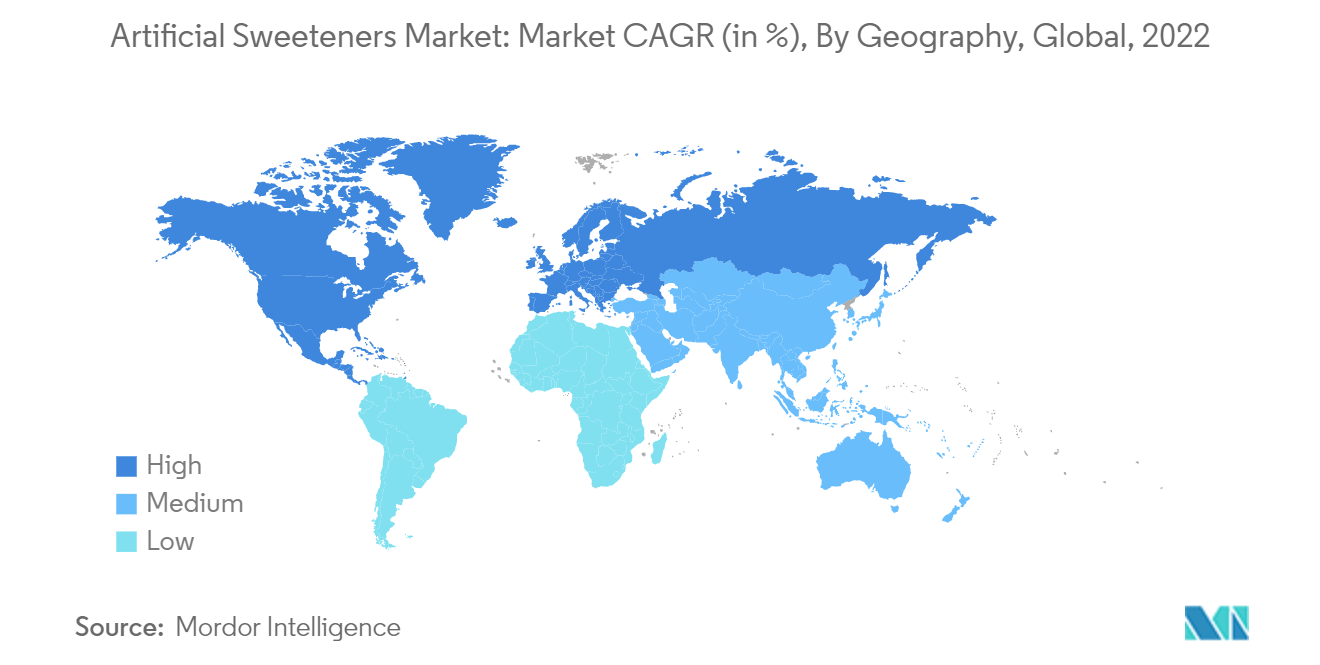
Artificial Sweetener Industry Overview
The market for artificial sweeteners is highly competitive, with both large and small regional players vying for market share. Leading manufacturers in the industry are leveraging advanced technologies to produce safe, affordable, and effective artificial sweeteners. Key players in the market include Whole Earth Sweetener, Ach Food, Madhava Sweeteners, Cargill Inc., Beijing Vitasweet Co. Ltd, Ajinomoto Co. Inc., and Tate & Lyle PLC.
To meet changing consumer preferences, companies in the food sweetener manufacturing segment are adjusting their production processes. Over the past few years, there has been a significant shift in consumer preferences toward clean-label and non-GMO products, and manufacturers are adapting accordingly. This trend is expected to continue in the years ahead.
Artificial Sweetener Market Leaders
-
Tate & Lyle
-
Cargill
-
Ingredion
-
ADM
-
Ajinomoto
*Disclaimer: Major Players sorted in no particular order
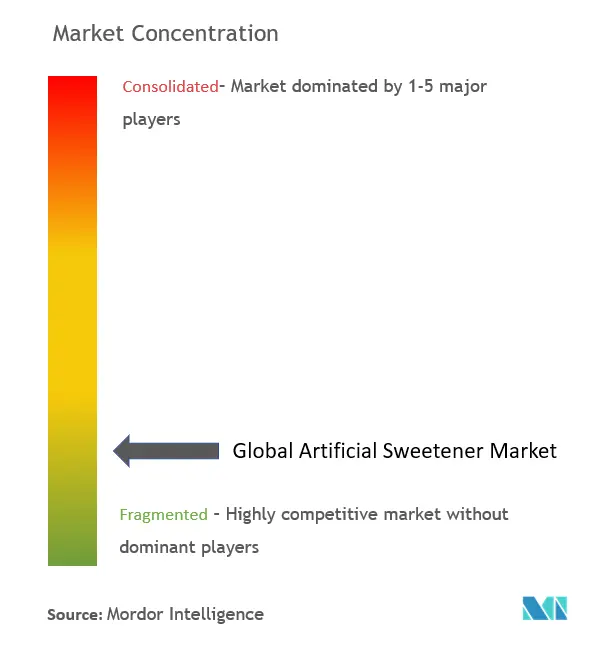
Artificial Sweetener Market News
- July 2021: PepsiCo announced its plans to reduce sugar content by 25% in sodas and iced tea beverage portfolios across the European Union (EU) by 2025. By introducing products with less sugar content, the company aims to catch the attention of health-conscious consumers in the region.
- January 2021: Tate & Lyle and Codexis extended their partnership to enhance the production of Tate & Lyle's newest sweetener: Tasteva M Stevia Sweetener. The new enzyme variants, which will replace existing Codexis enzymes, are expected to enable Tate & Lyle to convert raw material into more finished stevia and allulose, lowering the two products' already low cost of goods.
Artificial Sweetener Market Report - Table of Contents
1. INTRODUCTION
1.1 Study Assumptions and Market Definition
1.2 Scope of the Study
2. RESEARCH METHODOLOGY
3. EXECUTIVE SUMMARY
4. MARKET DYNAMICS
4.1 Market Drivers
4.2 Market Restraints
4.3 Porter's Five Forces Analysis
4.3.1 Threat of New Entrants
4.3.2 Bargaining Power of Buyers/Consumers
4.3.3 Bargaining Power of Suppliers
4.3.4 Threat of Substitute Products
4.3.5 Intensity of Competitive Rivalry
5. MARKET SEGMENTATION
5.1 Type
5.1.1 Aspartame
5.1.2 Acesulfame K
5.1.3 Saccharin
5.1.4 Sucralose
5.1.5 Neotame
5.1.6 Other Types
5.2 Application
5.2.1 Bakery Products
5.2.2 Dairy Products
5.2.3 Confectionery
5.2.4 Beverages
5.2.5 Other Applications
5.3 Geography
5.3.1 North America
5.3.1.1 United States
5.3.1.2 Canada
5.3.1.3 Mexico
5.3.1.4 Rest of North America
5.3.2 Europe
5.3.2.1 Spain
5.3.2.2 United Kingdom
5.3.2.3 Germany
5.3.2.4 France
5.3.2.5 Italy
5.3.2.6 Russia
5.3.2.7 Rest of Europe
5.3.3 Asia-Pacific
5.3.3.1 China
5.3.3.2 Japan
5.3.3.3 India
5.3.3.4 Australia
5.3.3.5 Rest of Asia-Pacific
5.3.4 South America
5.3.4.1 Brazil
5.3.4.2 Argentina
5.3.4.3 Rest of South America
5.3.5 Middle-East and Africa
5.3.5.1 South Africa
5.3.5.2 United Arab Emirates
5.3.5.3 Rest of Middle-East and Africa
6. COMPETITIVE LANDSCAPE
6.1 Most Adopted Strategies
6.2 Market Share Analysis
6.3 Company Profiles
6.3.1 Tate & Lyle
6.3.2 Cargill Inc.
6.3.3 Archer Daniels Midland
6.3.4 Ingredion Inc.
6.3.5 Roquette
6.3.6 Ajinomoto Co. Inc.
6.3.7 JK Sucralose Inc.
6.3.8 DuPont
6.3.9 Tereos SA
6.3.10 GLG Life Tech Corporation
- *List Not Exhaustive
7. MARKET OPPORTUNITIES AND FUTURE TRENDS
Artificial Sweetener Industry Segmentation
A sugar substitute is a food additive that provides a sweet taste like that of sugar while containing significantly less food energy than sugar-based sweeteners, making it a zero-calorie or low-calorie sweetener.
The artificial sweetener market is segmented by type (aspartame, acesulfame K, saccharin, sucralose, neotame, and other types), application (bakery, dairy, confectionery, beverages, soups, sauces and dressings, and other applications), and geography (North America, Europe, Asia-Pacific, South America, and Middle-East and Africa).
For each segment, the market sizing and forecasts have been done on the basis of value (in USD million).
| Type | |
| Aspartame | |
| Acesulfame K | |
| Saccharin | |
| Sucralose | |
| Neotame | |
| Other Types |
| Application | |
| Bakery Products | |
| Dairy Products | |
| Confectionery | |
| Beverages | |
| Other Applications |
| Geography | |||||||||
| |||||||||
| |||||||||
| |||||||||
| |||||||||
|
Artificial Sweetener Market Research FAQs
What is the current Artificial Sweetener Market size?
The Artificial Sweetener Market is projected to register a CAGR of 3.70% during the forecast period (2024-2029)
Who are the key players in Artificial Sweetener Market?
Tate & Lyle, Cargill, Ingredion, ADM and Ajinomoto are the major companies operating in the Artificial Sweetener Market.
Which is the fastest growing region in Artificial Sweetener Market?
Middle East and Africa is estimated to grow at the highest CAGR over the forecast period (2024-2029).
Which region has the biggest share in Artificial Sweetener Market?
In 2024, the Asia Pacific accounts for the largest market share in Artificial Sweetener Market.
What years does this Artificial Sweetener Market cover?
The report covers the Artificial Sweetener Market historical market size for years: 2019, 2020, 2021, 2022 and 2023. The report also forecasts the Artificial Sweetener Market size for years: 2024, 2025, 2026, 2027, 2028 and 2029.
Artificial Sweetener Industry Report
Statistics for the 2024 Artificial Sweetener market share, size and revenue growth rate, created by ����vlog��ý™ Industry Reports. Artificial Sweetener analysis includes a market forecast outlook to 2029 and historical overview. Get a sample of this industry analysis as a free report PDF download.



